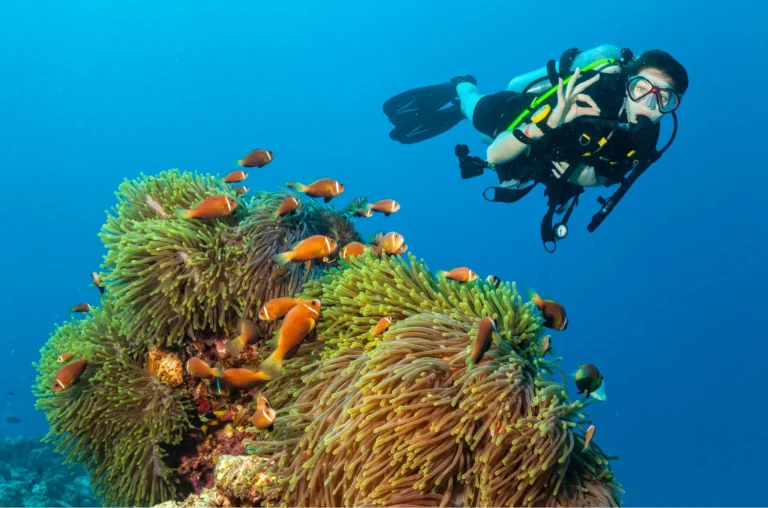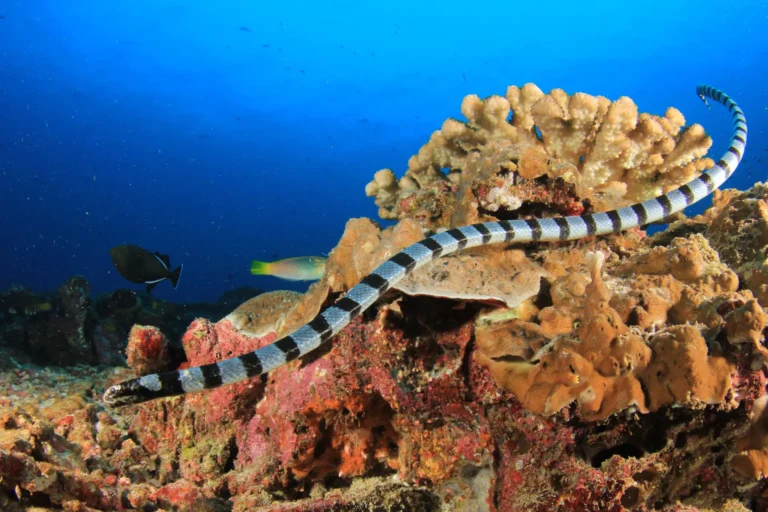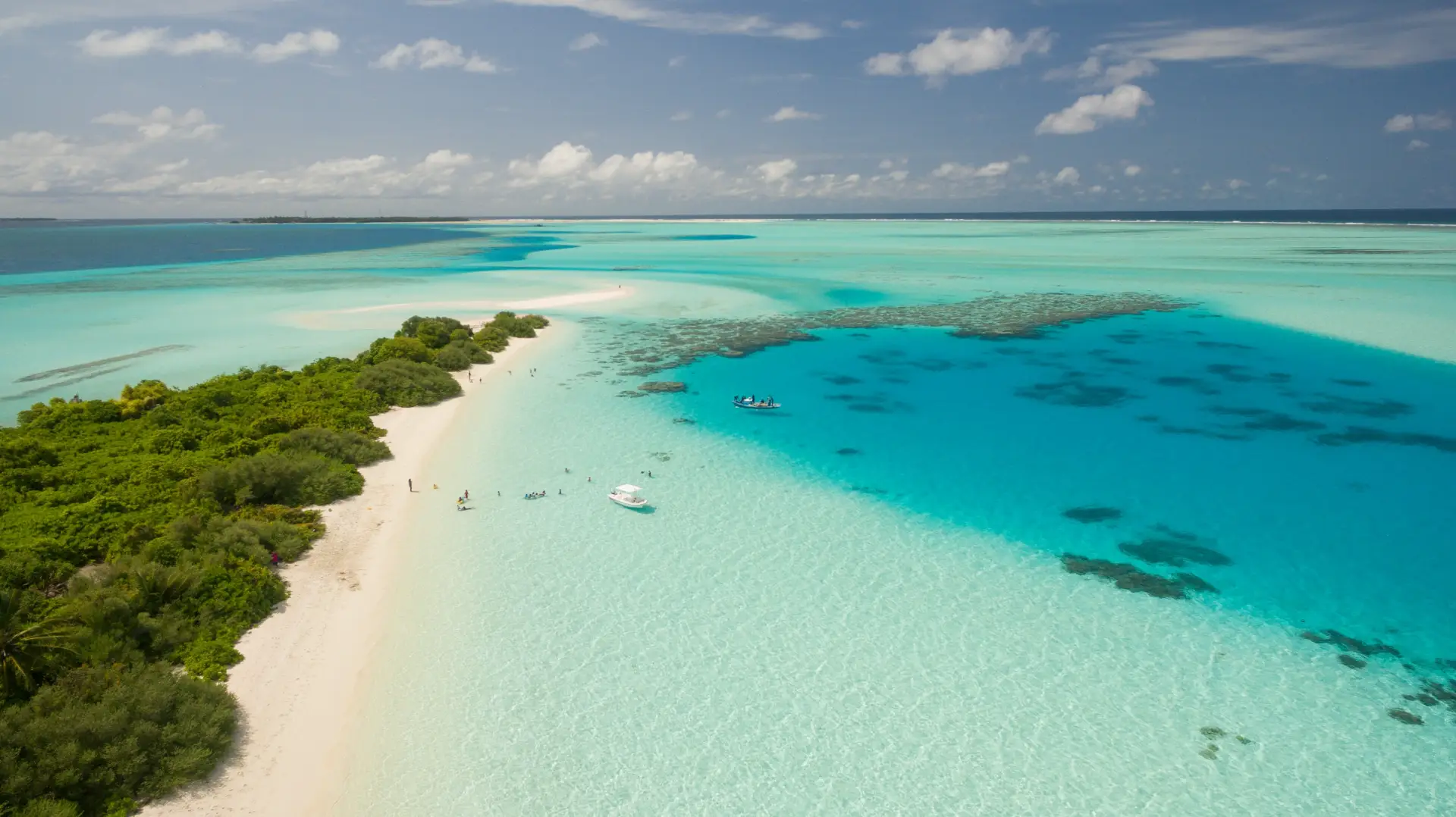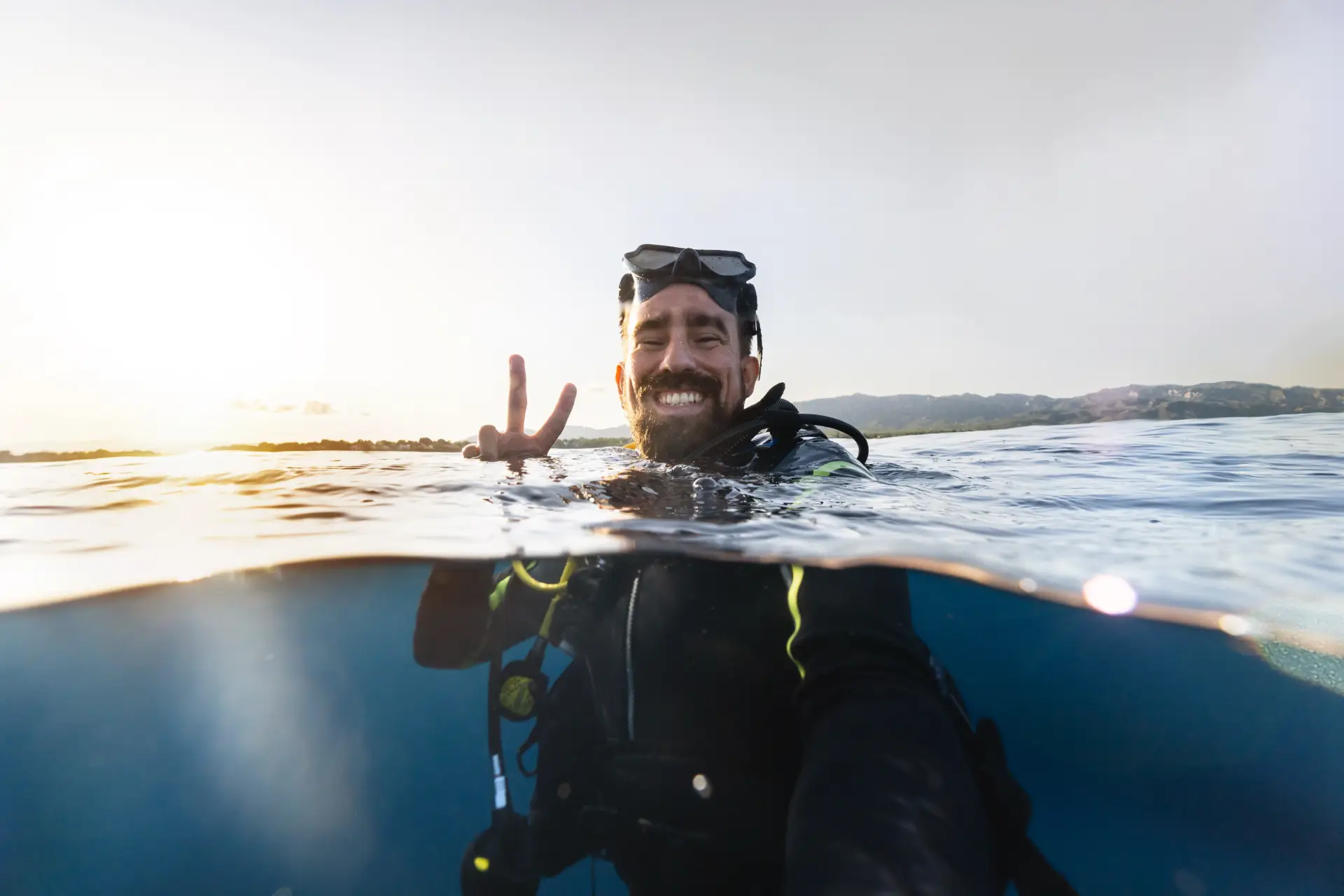More Time Underwater: 7 Pro Tips to Improve Your Scuba Air Consumption
It’s a feeling every diver knows. You’re gliding along a stunning coral wall at Balicasag Island, completely mesmerized by a green sea turtle peacefully munching on algae. The rest of your group is settled in, watching the show. But then you glance at your gauge, and your heart sinks a little. 75 bar. You know that in just a few minutes, you’ll have to be the one to signal the end of the magic for everyone.
Being the diver who always seems to run through air the fastest can be frustrating. You might think, “I’m just not built for diving,” or “My lungs are too big.” But here’s a secret from our team of PADI professionals at Sierra Madre Divers: great air consumption has very little to do with lung size and everything to do with skill, technique, and relaxation.
Improving your air consumption isn’t about “winning” or beating your buddy back to the boat with the most air. It’s about gaining more time to do what we love: exploring the incredible underwater world of Bohol. It’s about transforming your dives from a race against the gauge into a state of peaceful, prolonged immersion.
Ready to make every precious tank last longer? Here are seven professional tips that will dramatically improve your air consumption.
1. Become a Zen Master: Slow Down
This is the golden rule. Watch an experienced divemaster or instructor underwater. They are the epitome of calm, moving with a slow, deliberate grace that seems almost effortless. Now, watch a new diver. Their movements are often quick, jerky, and hurried.
Why it Works: Scuba diving is an exercise in efficiency. Every single movement you make requires muscular effort, which consumes oxygen and makes you breathe harder. Frantically finning, sculling with your hands, and constantly adjusting your gear is like sprinting a marathon. By consciously slowing everything down—your fin kicks, your turns, your thoughts—you reduce your physical workload dramatically. Less work means less oxygen demand, which means slower, deeper breathing and a much longer dive.
How to Practice: On your next dive, make it a mental exercise. Pretend you are moving through honey. Count to three in your head between each fin kick. When you want to turn, do it slowly, using one or two gentle kicks to pivot. Consciously relax your shoulders and arms. The reef isn’t going anywhere. Adopt a “stroll through the park” mentality, not a “race to the finish line” one.
2. Master the Art of Flight: Perfect Your Buoyancy
If slowing down is the golden rule, mastering buoyancy is the secret key that unlocks everything else. Constantly fiddling with your BCD inflator, kicking to stay down, or sculling to stay up is the number one cause of poor air consumption.
Why it Works: Every time you press that inflator button, you use a puff of precious air from your tank. Every time you kick upwards to avoid hitting the reef, you are working hard. When you are perfectly neutral, you are truly weightless. You can hold your position with minimal effort, using only your lungs to make minor adjustments in depth. A neutrally buoyant diver is a motionless, relaxed diver. A relaxed diver is an air-efficient diver.
How to Practice: This is a skill that requires dedicated practice. A great start is to sign up for the PADI Peak Performance Buoyancy (PPB) specialty course. Our instructors will work with you to fine-tune your weighting and teach you advanced techniques like hovering in different positions and using your breath to control your ascent and descent. It is, without a doubt, the single best investment you can make in improving your diving comfort and air consumption.
3. Drop the Lead: Get Properly Weighted
Hand-in-hand with buoyancy is weighting. Perhaps the most common mistake we see is divers wearing too much lead. They think it will help them get down faster, but it creates a vicious cycle of inefficiency for the entire dive.
Why it Works: When you are overweighted, you sink like a stone. To compensate, you have to add a large amount of air to your BCD to achieve neutral buoyancy. This inflated BCD is bulky and dramatically increases your drag, like trying to swim while towing a small parachute. To overcome this drag, you have to fin much harder, which, as we know, burns through your air. It’s a chain reaction of wasted energy.
How to Practice: At the start of your dive trip, do a proper weight check with an almost empty tank (around 50 bar / 700 PSI). With no air in your BCD, while holding a normal breath, you should float at eye level. When you exhale completely, you should sink slowly. If you sink like a rock, you have too much weight. Our divemasters are always happy to help you get this just right. Losing just a kilogram or two of unnecessary lead can make a world of difference.
4. Become a Sports Car, Not a Truck: Streamline Everything
Once you’re perfectly weighted, the next step is to reduce your drag. Think about the difference between a sleek Formula 1 car and a giant lorry. Which one cuts through the air more easily? You want to be the Formula 1 car.
Why it Works: Every piece of gear that dangles, sticks out, or flaps around creates resistance in the water. Your body has to work harder to push through that resistance. Tucking in your gauges, securing your octopus so it doesn’t drag, and keeping your arms folded or at your sides presents a smaller, tighter profile to the water. Less drag means less effort, and less effort means less air used.
How to Practice: Before you roll into the water, do a final check. Is your console clipped securely to a D-ring? Is your octopus tucked away where it’s accessible but not dangling? Are there any loose straps? Get your buddy to check you over, and do the same for them. It’s a simple step that makes a big difference.
5. Breathe Like a Yogi: Deep, Slow, and Deliberate
This can seem counterintuitive. Many divers think that taking smaller, shallower breaths will conserve air. The opposite is true.
Why it Works: Your body needs to get rid of carbon dioxide (CO2) just as much as it needs to take in oxygen. Shallow, rapid breathing is very inefficient at gas exchange. You don’t fully expel the CO2, which creates the urge to breathe again sooner. By taking a long, slow, deep inhalation and, just as importantly, a long, slow, full exhalation, you optimize this gas exchange. This purges CO2 effectively, satisfies your body’s oxygen demand more efficiently, and calms your nervous system, breaking the cycle of hurried breathing. Never hold your breath—the key is a continuous, slow cycle.
How to Practice: Spend the first few minutes of your dive focusing solely on your breathing. Inhale slowly for a count of five, then exhale slowly for a count of six or seven. You will feel your body relax. When you find your mind wandering or your breathing quickening, bring your focus back to this slow, deliberate pattern.
6. Finesse Your Finning: It’s All in the Hips
Are you a “bicycle kicker”? Do your knees bend a lot with short, frantic kicks? This is an incredibly common and inefficient way to swim.
Why it Works: Efficient propulsion comes from your powerful leg muscles, originating at the hips, not from your knees. Using a full, deliberate fin stroke—like the frog kick or a modified flutter kick with straight knees—gets you much more thrust for every movement. Fewer, more powerful kicks are infinitely more efficient than countless, frantic, weak kicks.
How to Practice: Ask your divemaster to watch your finning technique. Practice the frog kick—it’s a wonderfully relaxing and powerful kick for cruising over reefs. The key is to use slow, wide strokes and then enjoy a long glide phase after each kick, letting your momentum do the work.
7. Stay Toasty and Warm
Even in the beautiful, warm waters of Bohol, your body can lose heat over the course of a 50-minute dive. And a cold diver is an air-hungry diver.
Why it Works: Your body’s natural response to being cold is to burn energy to generate heat through metabolic processes and shivering. This increased metabolic rate requires more oxygen, causing you to breathe through your tank much faster, even if you don’t feel like you are “shivering” cold.
How to Practice: Choose the right exposure suit for the water temperature and your personal tolerance. If you tend to get cold, don’t be afraid to wear a 3mm full suit even when others are in shorties. A hood or a hooded vest can also dramatically reduce heat loss.
Mastering your air consumption is a journey, not a destination. By focusing on these seven tips, you will transform your diving experience. You’ll be more relaxed, more confident, and you’ll be rewarded with what every diver truly wants: more precious time exploring the magnificent underwater world we all love so much.
Come and practice your new skills with us at Sierra Madre Divers. Our team is ready to help you become the calm, efficient diver you’ve always wanted to be.







